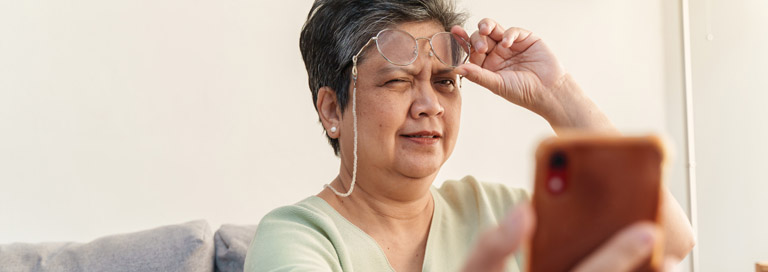Has your vision deteriorated sharply over the past couple of years?
If the answer is “yes,” you are probably another victim of a global health crisis that eye doctors refuse to acknowledge…
I’m talking about a condition called quarantine myopia – a health crisis caused by Covid restrictions and the hours we were forced to spend inside during the lockdown.
Recent studies of school-age children from the Netherlands and China reveal that myopia – or “near-sightedness” – has increased dramatically since the lockdown.1
Using data from more than 120,000 schoolchildren, studies reveal that kids are up to three times more likely to have myopia in 2020 than children in previous years.2
But it’s not just children whose eyesight has suffered because of the lockdown.
You see, good eye health requires that you spend a good chunk of time outdoors every day.
That’s because daylight is essential for normal eye health.
When you’re indoors, light intensity is obviously much less compared with being outside on a bright day. Studies from Norway show that myopia increases in the darker seasons while it decreases during brighter times of the year.3
Our eyes did not evolve to spend hours inside a dimly lit room.
Your eyes evolved as a matter of survival to focus light onto images. Crucial to our image-forming eyes was the evolution of lenses that could focus light.
Long periods indoors cause changes in the shape of your eyeball and the thickness of the eye lens.
Both of these can result in myopia. In fact, studies show that eye lenses are much thinner in patients with myopia than those with 20:20 vision.4
The natural light of the sun is what gave our primal ancestors healthy vision. That’s because sunlight triggers the release of dopamine in the retina. This helps control the
growth and development of the eye.When you don’t get enough dopamine, your eye grows out of control. It stretches lengthwise like an egg.
Animal studies show that natural sunlight – at about 30,000 lux (a measure of brightness) – produces enough dopamine to stop your eye from growing into the myopic egg shape.
But typical home lighting, at about 500 lux, does not.5
Sun exposure really works.
In one Chinese study, teachers were asked to send children outside for 80 minutes a day. After one year, only 8% developed myopia, compared with 18% at a control school.
Sadly, mainstream medicine today views the sun as your enemy.
I advise my patients to get plenty of natural sunshine. Healthy vision is one more good reason to get outdoors every day.
And why it’s so important to encourage your kids and grandkids to put down their iPads and go outside to play. Of course, tell them never to look directly at the sun, as the benefit to their eyes comes from just being outside.
But it’s not just children who face these vision problems.
Lockdown forced all of us to spend more time focusing indoors.
Protect Your Eye Health And Your Vision
Apart from spending more time in the sun, there are a number of ways you can prevent eyesight deterioration. In addition to the nutrients I recommend for eye health, here’s what else I tell my patients:
-
- Give your eyes a break. You can reduce your risk of myopia – or avoid making it worse – by not staring for too long at an object at close range. The important factor is distance. You should look up regularly so that your gaze can wander into the distance, preferably out your window, to look at objects that are far away.
Follow the 20-20-20 rule. Every 20 minutes or so, stop what you’re doing and focus on something 20 feet away for 20 seconds. This is especially important if you’re reading or looking at your phone or computer. - Know when to wear sunglasses: I reserve wearing sunglasses for high-intensity sun activities like snow skiing and water sports. Snow and water can magnify sunlight and increase the risk of damage. I also use them when I’m out in intense sunlight for extended hours.
It’s important to choose the right kind of sunglasses. Look for a pair with “99-100% UV absorption.” Or look for “UV 400.” This means they block all UVA and UVB rays. “Polarized” glasses help reduce glare, but they don’t necessarily meet that UV standard. - Nourish your eyes with vitamin A. Most doctors will tell you to eat carrots and orange vegetables like squash to get vitamin A. But I don’t…
These foods contain beta-carotene that your body has to convert into retinol, the active form of vitamin A. But your body doesn’t make that conversion very efficiently. And millions of people can’t make that conversion, including diabetics and people with thyroid issues.
I recommend getting your vitamin A from animal products and animal fats. That means grass-fed liver, fish, eggs, cheese, and raw milk. To protect your eyes, you need at least 5,000 IU a day.
- Give your eyes a break. You can reduce your risk of myopia – or avoid making it worse – by not staring for too long at an object at close range. The important factor is distance. You should look up regularly so that your gaze can wander into the distance, preferably out your window, to look at objects that are far away.
To Your Good Health,
![]()
Al Sears, MD, CNS
References:
1. Klaver CCW, et al. “2020 as the Year of Quarantine Myopia.” JAMA Ophthalmol. 2021;139(3):300–301.
2. Wang J, et al. “Progression of Myopia in School-Aged Children After COVID-19 Home Confinement.” JAMA Ophthalmol. 2021;139(3):293–300.
3. Hagen LA, et al. “Prevalence and Possible Factors of Myopia in Norwegian Adolescents.” Sci Rep. 2018 Sep 7;8(1):13479.
4. Muralidharan G, et al. “Morphological changes of human crystalline lens in myopia.” Biomed Opt Express. 2019 Nov 5;10(12):6084-6095.
5. Rose KA, et al. “Outdoor activity reduces the prevalence of myopia in children.” Ophthalmology. 2008;115(8):1279–1285.

